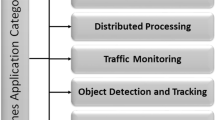Abstract
In sparse wireless sensor networks, a mobile robot is usually exploited to collect the sensing data. Each sensor has a limited transmission range and the mobile robot must get into the coverage of each sensor node to obtain the sensing data. To minimize the energy consumption on the traveling of the mobile robot, it is significant to plan a data collection path with the minimum length to complete the data collection task. In this paper, we observe that this problem can be formulated as traveling salesman problem with neighborhoods, which is known to be NP-hard. To address this problem, we apply the concept of artificial bee colony (ABC) and design an ABC-based path planning algorithm. Simulation results validate the correctness and high efficiency of our proposal.







Similar content being viewed by others
References
Arkin EM, Hassin R (1994) Approximation algorithms for the geometric covering salesman problem. Discrete Appl Math 55(3):197–218
Chiu KM, Liu JS (2011) Robot routing using clustering-based parallel genetic algorithm with migration. In: IEEE workshop on merging fields of computational intelligence and sensor technology (CompSens) (2011), pp 42–49
Comarela G, Gonçalves K, Pappa GL, Almeida J, Almeida V (2011) Robot routing in sparse wireless sensor networks with continuous ant colony optimization. In: Proceedings of the 13th annual conference companion on genetic and evolutionary computation (GECCO ’11). ACM, New York, pp 599–606
De Berg M, Gudmundsson J, Katz MJ, Levcopoulos C, Overmars MH, van der Stappen AF (2005) Tsp with neighborhoods of varying size. J Algorithms 57(1):22–36
Dorigo M, Gambardella L (1997) Ant colony system: a cooperative learning approach to the traveling salesman problem. IEEE Trans Evol Comput 1(1):53–66
Dorigo M, Stützle T (2004) Ant colony optimization. Bradford Company, Scituate
Elbassioni K, Fishkin AV, Mustafa NH, Sitters R (2005) Approximation algorithms for euclidean group tsp. In: Proceedings of the 32nd international colloquim on automata, languages and programming (ICALP). Springer, Lisbon, Portugal, pp 1115–1126
Gao WF, Liu SY (2012) A modified artificial bee colony algorithm. Comput Oper Res 39(3):687–697
Gentilini I, Margot F, Shimada K (2013) The travelling salesman problem with neighbourhoods: Minlp solution. Optim Methods Softw 28(2):364–378
Karaboga D, Basturk B (2008) On the performance of artificial bee colony (abc) algorithm. Appl Soft Comput 8(1):687–697
Karaboga D, Okdem S, Ozturk C (2010) Cluster based wireless sensor network routings using artificial bee colony algorithm. In: Proceedings of the 2010 international conference on autonomous and intelligent systems (AIS ’10). pp 1–5
Li L, Cheng Y, Tan L, Niu B (2011) A discrete artificial bee colony algorithm for tsp problem. In: Proceedings of the 7th international conference on Intelligent Computing: bio-inspired computing and applications (ICIC’11). Springer-Verlag, Berlin, pp 566–573.doi:10.1007/978-3-642-24553-4_75
Lin S, Kernighan B (1973) An effective heuristic algorithm for the traveling-salesman problem. Oper Res 21(2):498–516
Little J, Murty K, Sweeney D, Karel C (1963) An algorithm for the traveling salesman problem. Oper Res 11(6):972–989
Papadimitriou C (1997) The euclidean traveling salesman problem is np-complete, vol 4. Elsevier, pp 237–244. http://www.sciencedirect.com/science/article/pii/0304397577900123
Safra S, Schwartz O (2006) On the complexity of approximating tsp with neighborhoods and related problems. Comput Complex 14(4):281–307
Tekdas O, Isler V, Lim JH, Terzis A (2009) Using mobile robots to harvest data from sensor fields. Wirel Commun 16(1):22–28
Yick J, Mukherjee B, Ghosal D (2008) Wireless sensor network survey. Comput Netw 52(12):2292–2330
Yuan B, Orlowska M, Sadiq S (2007) On the optimal robot routing problem in wireless sensor networks. IEEE Trans Knowl Data Eng 19(9):1252–1261
Author information
Authors and Affiliations
Corresponding author
Rights and permissions
About this article
Cite this article
Chang, WL., Zeng, D., Chen, RC. et al. An artificial bee colony algorithm for data collection path planning in sparse wireless sensor networks. Int. J. Mach. Learn. & Cyber. 6, 375–383 (2015). https://doi.org/10.1007/s13042-013-0195-z
Received:
Accepted:
Published:
Issue Date:
DOI: https://doi.org/10.1007/s13042-013-0195-z




